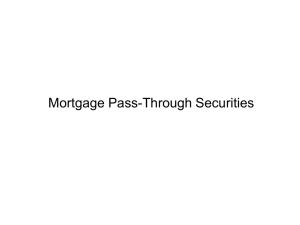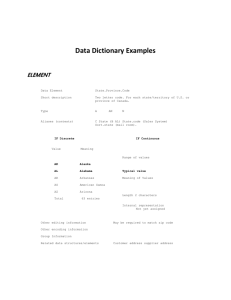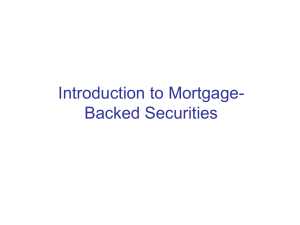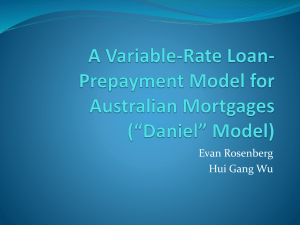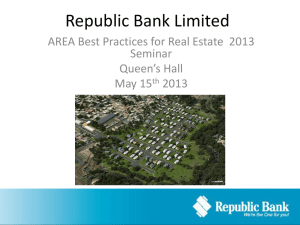The Option Structure of a Mortgage Contract
advertisement
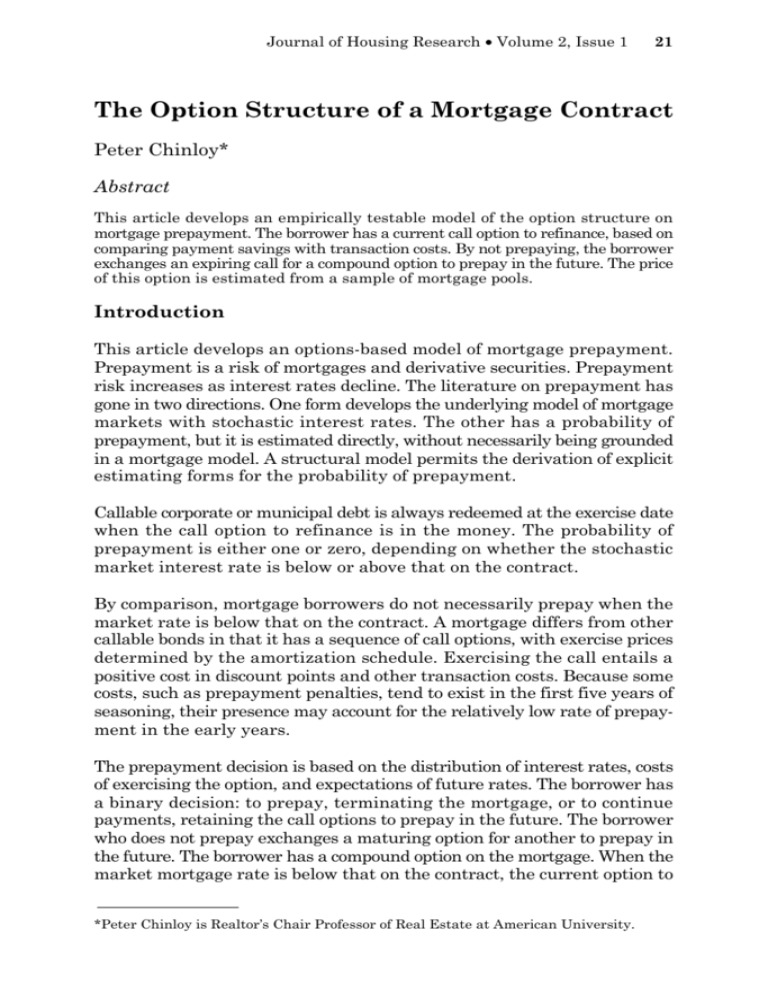
Journal of Housing Research • Volume 2, Issue 1 21 The Option Structure of a Mortgage Contract Peter Chinloy* Abstract This article develops an empirically testable model of the option structure on mortgage prepayment. The borrower has a current call option to refinance, based on comparing payment savings with transaction costs. By not prepaying, the borrower exchanges an expiring call for a compound option to prepay in the future. The price of this option is estimated from a sample of mortgage pools. Introduction This article develops an options-based model of mortgage prepayment. Prepayment is a risk of mortgages and derivative securities. Prepayment risk increases as interest rates decline. The literature on prepayment has gone in two directions. One form develops the underlying model of mortgage markets with stochastic interest rates. The other has a probability of prepayment, but it is estimated directly, without necessarily being grounded in a mortgage model. A structural model permits the derivation of explicit estimating forms for the probability of prepayment. Callable corporate or municipal debt is always redeemed at the exercise date when the call option to refinance is in the money. The probability of prepayment is either one or zero, depending on whether the stochastic market interest rate is below or above that on the contract. By comparison, mortgage borrowers do not necessarily prepay when the market rate is below that on the contract. A mortgage differs from other callable bonds in that it has a sequence of call options, with exercise prices determined by the amortization schedule. Exercising the call entails a positive cost in discount points and other transaction costs. Because some costs, such as prepayment penalties, tend to exist in the first five years of seasoning, their presence may account for the relatively low rate of prepayment in the early years. The prepayment decision is based on the distribution of interest rates, costs of exercising the option, and expectations of future rates. The borrower has a binary decision: to prepay, terminating the mortgage, or to continue payments, retaining the call options to prepay in the future. The borrower who does not prepay exchanges a maturing option for another to prepay in the future. The borrower has a compound option on the mortgage. When the market mortgage rate is below that on the contract, the current option to *Peter Chinloy is Realtor’s Chair Professor of Real Estate at American University. 22 Peter Chinloy prepay, expiring at the next payment date, becomes more valuable. If this decline in rates is expected to continue, options to refinance at future payment dates also increase in price. With positive costs of prepayment and expectations of future valuable call options, a utility-maximizing borrower need not prepay even when an option is in the money. It can be optimal to prepay when current interest rates are above those on the contract. This behavior is attributable strictly to financial considerations. A mortgage is a complex financial contract containing a flow of income, an amortization of principal, and a series of options to prepay. The series of call options provides that the borrower can purchase the loan from the lender, at the contractual balance outstanding, during any payment period prior to maturity. The exercise price of the option is the loan balance. The exercise date is the payment date. The asset on which the option is written is the savings from prepayment. During each payment period, the borrower has an American option to prepay. If this prepayment option is not exercised, it is exchanged for a compound option to prepay in the future. The price of the current call option, also termed the intrinsic return to refinancing, is the present value of savings less transaction costs. With interest rates deterministic, Siegel (1984) shows that it is always optimal to refinance when this call option is in the money. The observed evidence that borrowers do not exercise in-the-money refinancing options suggests a response to stochastic interest rates. Chen and Ling (1989) argue that the current call must be compared with the future compound option to refinance. Kau et al. (1990) have a mortgage model in which the probability of both prepayment and default is endogenous.1 All models require a probability of prepayment to determine the expected cash flow to the mortgage lender and to price the mortgage. The objective of this article is to develop a testable prepayment model incorporating both the intrinsic current call and the future compound option to prepay. Other prepayment specifications are based on historical data. Tables of yields and prices of mortgage securities reflect this historical experience. Mortgage pools are priced with prepayments as multiples of the Federal Housing Administration (FHA) and the Public Securities Association series. A pool with 100 percent FHA experience prepays at the same rate as that observed by the FHA. This structure does not have a behavioral 1 Hendershott and Van Order (1987) compare various mortgage pricing models. Previous research has developed a probability of prepayment based on interest rate, age, and seasoning. Examples are in Green and Shoven (1986) and Schwartz and Torous (1989). The Option Structure of a Mortgage Contract 23 model of prepayment.2 By explicit modeling of the mortgage as an options package, the characteristics of loan financing can be included in the probability of prepayment. The options, probability of prepayment, and value of mortgages and securities depend on transaction costs of the borrower. These costs are prices charged for refinancing when the option is exercised. Without these costs, the borrower has an incentive to refinance whenever market interest rates are below those on the contract. During each period, the borrower searches among diverse market contracts and decides whether to prepay. By not prepaying in the current period, the borrower receives a sequence of options to prepay in the future. Prepayment depends on interest and discount rates, expectations of future rates, transaction costs, and terms of the existing mortgage contract. Mortgage and derivative security pricing models that include only the current option to prepay are liable to involve mispricing. The risks of future prepayment are not captured by a cash flow pricing model. In a cash flow model, the lender receives a mortgage payment and a lump sum from current prepayment. The risk from future prepayment is excluded. A complete model of mortgage markets must include transaction costs, such as points. Without these costs, the mortgage prepayment decision degenerates into a knife-edge because the borrower refinances at every period in which the current interest rate is lower than the existing contract rate. Options and Mortgages A mortgage provides the borrower with an option to buy the loan from the lender on or before the next payment date. If the current call is exercised, the mortgage is prepaid. An unexercised current call is exchanged for a sequence of options to refinance in the future. Not all of the loan need be prepaid, and not all is prepaid when a call is in the money. The options package is developed for a mortgage with a fixed interest rate ® amortized over ° periods. The payment is (1) During each period t = 0,. . . , °, the borrower has an option to prepay the mortgage. The outstanding balance on the loan is ¯t,t = 0, . . . , ° per 2 The Salomon Brothers (1988) tables contain these prices. As an alternative, Dunn and McConnell (1981a,b) use a stochastic difference equation for the price of a mortgage-backed security subject to prepayment. 24 Peter Chinloy dollar borrowed. The mortgage payment is divided between interest and principal as ! = ®¯ t–1 – (¯t – ½t–1 ). Solving this first-order difference equation, subject to the initial condition ¯ 0 = 1, the exercise prices, the loan balances outstanding, are (2) The price of the call on the mortgage is (3) The price of the underlying asset on which the option is held is p t , the present value of the savings from prepayment. The savings from prepayment depend on the market mortgage rate r, with probability density function f(r) and the contract rate ®. If r < ®, the option to prepay is potentially in the money. The payment on a market mortgage for term ° is By refinancing, the borrower saves ! – m(r) per period. The present value of an annuity at rate r, term ° is A ≡ 1/ m(r), using the market mortgage rate for discounting. The prices of the asset and option are suppressing the time subscript. The amount received on refinancing cannot exceed the outstanding loan balance. This no-cashout condition is consistent with most fixed-rate mortgages.3 When (! / m) > 1, the existing payment exceeds that obtainable by refinancing, and the call option is in the money. The price of the underlying asset is the payment ratio multiplied by the loan balance. This specification describes the option if mortgages are analogs of callable 3 If equity cashout is permitted, the borrower may have an incentive to refinance at unfavorable market rates. Equity is unlocked, and capital market imperfections may restrict other borrowings. The Option Structure of a Mortgage Contract 25 municipal or corporate debt. Suppose the market interest rate r is below the contract rate ®. With no costs of exercising the prepayment option, the borrower should refinance with certainty, even for a one-period horizon. Yet prepayment does not occur with certainty, and borrowers hold mortgages with market rates below those on the contract. What is missing are the transaction costs charged on the replacement mortgage. A market mortgage has conditions (r, e) , where e denotes these costs, such as points. These transaction costs are a price paid for exercising the option to refinance. If refinancing does not take place, no costs are paid. The borrower retains the sequence of options to refinance in the future. With these costs, the price of the current call option is (4) The call price depends on the volatility of the market rate r, the contract payment !, exercise price ¯, and e. As transaction costs increase, the price of the call option declines. Since the payment m is increasing in r, the option price is decreasing in the level—as opposed to the risk—of market interest rates. The option price determines the equilibrium tradeoff between interest rate and transaction costs for the borrower. For a constant call price, and given the parametric payment ! and loan balance ¯, the transaction cost-rate tradeoff is (5) with a subscript denoting a derivative because A ≈ 1/ r, Ar ≈ –1 / r2. The tradeoff is negative and independent of the level of costs. Higher market rates reduce the savings from refinancing, so the call option is less valuable. To restore equilibrium for the borrower, transaction costs must be reduced. On a given market mortgage, higher interest rates are associated with lower points. For an increase in interest rates, the tradeoff response is 2® / r3 > 0. The tradeoff becomes less negative as interest rates increase. The option price c applies during the current payment period. However, as part of the contract, the borrower can refinance during any payment period. In the future, there is a series of options to prepay over s = t + 1, . . . , ° . The expected interest rate is rs,t, with expectations formed in the current period t. The corresponding mortgage payment is ms,t. The current interest rate r is used to determine the present value of these future options. 26 Peter Chinloy The present values of future prepayment options are (6) Nonzero transaction costs, together with future options to prepay, ensure that the borrower need not refinance when r < ®. Borrowers have different costs of refinancing, associated with search and transaction costs. These cost differentials indicate that prepayment need not occur when market rates fall below those on the contract. If the borrower expects declining interest rates, with rs,t < r, and if refinancing has positive costs, with e > 0, it pays to delay. If points e = 0, the borrower refinances whenever r < ®. The prepayment decision and its probability cannot be modeled without explicitly including transaction costs. The Option Package and Prepayment The uncertain exercise of call options gives rise to a probability of prepayment q. With no points, there is no charge for exercising the option, and the probability degenerates to (7) With points, and the sequence of future call options over the term of the mortgage, there is a behavioral probability of prepayment q. This probability obeys the discrete law The probability of prepaying the current option is qt , at price ct. The differential between the price of the current call and the most valuable future option is where cs,t,s = t + 1, . . . , γ is the expected price of the future option to prepay. This probability of prepayment is a quantal choice (8) The Option Structure of a Mortgage Contract 27 dependent on the market interest rate, future expectations of interest rates, and existing contract terms. The expected value of the package of call options is (9) During the current payment period, the probability of prepaying is qt. The probability of not prepaying is The value of the option package in the succeeding period satisfies (10) where qs,t,s = t + 1, . . . , ° are the probabilities of prepayment viewed forward from date t + 1. These are conditional probabilities, given that the borrower does not refinance at date t, so (11) and the value of the mortgage option package is (12) A fixed-rate mortgage contains a current call option, priced at ct, and a package of future options to refinance, priced at ut+1 . The borrower refinancing in the current period has qt = 1, and the future package has no effect. If the borrower fails to refinance in the current period, a compound option is acquired for future prepayment. The value of the refinancing package is a probability-of-prepayment weighted average of the current and compound options. An alternative specification is for the value of the package to be the maximum of the current and compound options, or This form is used in Chen and Ling (1989). For the standard mortgage, the payment period is one month. The oneperiod-ahead package is worth the current package times (1 + at), where at 28 Peter Chinloy is the short-term interest rate per month.4 The linkage between current and future option packages is (13) Substituting, and with all variables measured at current date t, v = qc + (1 – q)(1 + a)v. (14) Rearranging, the value of the option package is substituting for the call option. Because v is a price for a package of options, it is nonnegative. If q(1 + a) >a, v>0. When q(l + a) < a, v = 0. This is a restriction on the short-term rate a. Higher short rates make the future package of options less valuable. At some short-term rate, given long mortgage rates, it does not pay to delay refinancing. Future options are less valuable as the yield curve slope flattens, becoming less positive or possibly negative. When current prepayment is certain, q = 1. Then v = c , and future options to prepay carry no weight. In the current call, (15) if q(l + a) – a > 0. The comparative statics of the option package are indicated in table 1. The value of the option package is increasing in the price of the current call c, the contract rate a, the loan balance ¯, and the payment !. It is decreasing in short- and long-term market rates a and r, the probability of prepayment q, and the points e. A higher prepayment probability reduces the value of future options, as do increases in points. 4 The value of the package v has a declining-horizon effect because of amortization ¯ . The Option Structure of a Mortgage Contract 29 Table 1. Price of the Option Package and Its Determinants Variable Description Effect Probability of prepayment Price, current call option Short-term interest rate Market long mortgage rate Contract mortgage rate Loan balance outstanding Loan payment Points, refinancing charge Note: z ≡ q (1 + a) – a. Mortgage Pricing The option package has implications for the pricing of mortgages. The borrower carries the mortgage as a liability. The direct lender, or indirect holder of a mortgage-backed security, carries the loan as an asset, producing income Y. The mortgage price P (a,r,t) depends on the short rate a, the long rate r, and age or seasoning t.5 The interest rates follow the process where dz is the increment of a Wiener process with mean zero. Also, for alternative observations i and j, dzi dzj = dt for i = j, and dzi dzj = 0 otherwise. The variance-covariance matrix of interest rates is These two interest rates correspond to the two-state pricing model for an income-producing asset of Brennan and Schwartz (1985). 5 In application, sometimes a long U.S. treasury bond rate is used for r. The reasons are the absence of complete time series and the desire to avoid pricing an asset by using its own interest rate. These issues are discussed in Schwartz and Torous (1989). 30 Peter Chinloy Under appropriate arbitrage conditions, the mortgage price P with the two interest rates satisfies (16) + Subscripts on P denote partial derivatives. This partial differential equation has boundary conditions P0 = 1 Pr = 0 (17) to correspond with the amortization ¯0 = 1 and ¯° = 0. If the mortgage precludes any prepayment and there is no default risk, then income is the payment alone. On a bullet loan, as for construction and development, prepayment is often prohibited, and payments involve straight interest with no amortization. Under these conditions, Y = a per dollar of loan. Residential mortgages typically do not prohibit prepayment. One method of accommodating prepayment is with a cash flow specification. The lender receives ! per payment period, and if the mortgage is prepaid, with probability q, a loan balance lump sum ¯t is received early. Using only the current option, the cash flow to the lender is Y = ! – qc = ! − q(P − ¯). (18) The P – ¯ is the realized capital loss on refinancing. A variant of the cash flow form is with total receipts ! + q¯. The cash flow form neglects the future options held by the borrower. A borrower may not refinance in the current period even if interest rates in the market are below those on the contract. There remains an increased risk of prepayment, not recognized in current cash flow. The pricing of mortgages and derivative securities is inaccurate if this risk is excluded. The lender receives a mortgage payment ! and bears the liability for the current prepayment liability qtct and for future prepayment (1 – qt)υt+1. Income is (19) with the call option on the refinancing savings being c = ¯[ ! / m – (1 + e)]. The Option Structure of a Mortgage Contract 31 Substituting for income in the pricing equation for the mortgage or derivative security, (20) From this partial differential equation, subject to the boundary equations, the price of the mortgage P can be solved. A call option on the mortgage security is priced at C = P – ¯. (21) As an alternative specification, the mortgage and options are priced using the Black and Scholes (1973) and Merton (1973) form. Its advantage is a more conventional use in option pricing. A disadvantage is that there is a single interest rate. Shifts in the slope of the yield curve cannot be accommodated. Under this specification, the mortgage or security has a price P(r, t) at time t. It obeys the partial differential equation (22) A call option on the security is C = P – ¯. Empirical Results Empirical application involves the specification of the mortgage pricing equation and the call option on it. The two alternative forms contain one and two interest rates. The partial differential equation requires data on Y, the net income to the lender. This requires estimation of the probability of prepayment and the pricing of a call option on refinancing. This information is used in the mortgage pricing equation and the price of a call option on the mortgage. Probability of Prepayment The data are monthly observations on mortgage pools originated and serviced by a thrift operating in San Jose, California. This thrift has established itself as offering competitive interest rates on conforming fixedrate mortgages sold to the secondary market. All the pools in the sample are 32 Peter Chinloy for the Government National Mortgage Association (GNMA). Backed by the “full faith and credit” of the U.S. Treasury, these mortgages and pools are free of default risk, though not of prepayment risk. The data set contains the monthly reports received from GNMA by the thrift. The mortgages in the pool have the same contract interest rate. Reported are the number of loans outstanding in the pool each month. If the number of loans has been reduced, at least one has been prepaid. The prepayment of a loan reduces the total balance outstanding on the pool. The amount of regular payment of principal and interest is reduced. A voluntary payment of principal, without prepayment of the loan, does not reduce the regular payment. A distinction must be drawn between borrowers who prepay fully and those who prepay a portion of their principal. The two groups are distinguished as between “exiting” and “staying” in the pool. A prepayment rate, based on the exiting mortgages, is constructed for each pool and month. Because in many months there are no prepayments, the prepayment function is estimated as a Tobit. The sample period is January 1986 through May 1989, with monthly observations on the pools. The proportion prepaying is used to estimate the probability of prepayment as q = q(r,®,t), where r is the average market rate on newly originated fixed-rate mortgages, ® is the contract rate, and t is the seasoning or age of the loan. Based on a Tobit specification, the results are, with standard errors in parentheses, q = 0.0813 – 1.7951(0.7635)r + 0.9063(0.0688)® + 0.0012(0.0024)t. The R2 is 0.49, and there are 1,768 pooled time series and cross-section observations. The greater the contract rate, the higher the probability of prepayment. The lower the market interest rates, the higher the probability of prepayment. Age and seasoning do not affect the probability of prepayment, contrary to evidence in Green and Shoven (1986). The call option on refinancing is c = ¯[ ! / m – (1 + e)], where ¯ and ! are determined by the constant rate and term of the pool. The payment is m(r), and the call option can be priced using this rate. The probability of prepayment depends on the market interest rate in the lender survey, r, expectations of future interest rates for the call option, and the conditions on the contract. The prepayment function is q(c,ct+1,t, . . . , c°,t). The Option Structure of a Mortgage Contract 33 The data are combined across the pools in the sample. The contract rate and term for each pool are known, and their inclusion in estimation establishes a pool effect. The future options depend on interest rates rs,t, with expectations formed at s, for s = t + 1, . . . , °. Each pool has an observed flow of prepayment each month. Long-term mortgage rates are tied to long-term treasury bond rates, but with a lag. Treasury bond rates are used to determine borrowers’ future mortgage rate expectations. The future mortgage rates are constructed as the three-period forward leads of treasury long bond rates plus the current GNMA-treasury yield premium. The current prepayment call option is c = [ (! / m – (1 + e)] ¯ . The future options use the lead interest rate rt+1,t = Gt–3 + rt – Gt , where G is the interest rate on treasuries. The lagged treasury rate is Gt–3, and the premium is rt – Gt. This specification accounts for lags by lenders in setting mortgage rates. The future call options cs,t,s = t + 1, . . . , ° use these interest rates, and points are set at the current average in the market. The specification of prepayment is with a linear probability model in the current call option and the next three expected future call options. The probability is expressed in percentage points as q = 1.42 + 0.21c – 0.03c+1 + 0.02c+2 – 0.04c+3, (0.61)(0.09) (0.01) (0.06) (0.04) (23) with standard errors in parentheses. The the sample size is 653, +1 , c +2 , and c are the lead options. The observations are pooled time and c +3 series and cross sections.6 This equation is estimated for all the pools together. Fitted values are obtained for each pool. The sample means by pool are reported as probabilities of prepayment, together with current call option prices in table 2. 6 Estimating properties are discussed in Mundlak (1978). 34 Peter Chinloy Table 2. Call Price and Probability of Prepayment (sample means) Pool Current Call Option Prepayment Probability 1 2 3 4 5 6 7 8 9 10 11 12 13 0.075 0.094 0.010 0.082 0.010 0.034 0.010 0.022 0.046 0.034 0.027 0.058 0.010 0.233 0.354 0.103 0.270 0.110 0.155 0.107 0.156 0.212 0.255 0.131 0.223 0.118 The mean call price is 0.039 with a standard deviation of 0.034. The mean probability of prepayment is 0.187 with a standard deviation of 0.075. The probabilities are reported as annual averages. The range is from a low of 10.3 percent to a high of 35.4 percent. Green and Shoven (1986) estimate the probability of prepayment for single-family individual mortgages originated by two California thrifts as ranging between 18 percent and 33 percent between years 2 and 18. The probability of prepayment in the first year is 6 percent. Schwartz and Torous (1989), applying a similar model, find the probability of prepayment attaining a maximum at six years of mortgage age.7 Implications for Mortgage Securities The probability of prepayment q and the price of the call option on refinancing have been obtained. Estimates of the parameters of the interest rate distributions are required. Time series for January 1986 through May 1989 on treasury bills and 30-year treasury bonds are used for a and r, the short and long rates. In first differences, the estimating equations are 7 The probability of prepayment in both models involves the proportional hazard function q = ±½(± t)ρ–1 /1+(± t)½ where t is the age. The estimates in Schwartz and Torous (1989) are ± = 0.015 and ½ = 2.312. Shift factors are included in the estimation. The Option Structure of a Mortgage Contract 35 with = 0,and dzrdza = σra/σrσadt, and the error terms dzr and dza have a joint normal distribution. The two equations for r, a are estimated using the specification of Brennan and Schwartz (1985), with standard errors in parentheses. The short rate has a time trend and a risk premium r – a. The correlation coefficient between the errors is 0.37. The contemporaneous covariance, using the maximum likelihood invariance property, is σr,a = 0.37* 0.0298* 0.11 = 0.00121. The remaining parameter is the market price of risk Ãr. Substituting the five estimates for the means and variance-covariance matrix, and the probability of prepayment and option price on payment q, c, with the short and long rates a and r, only the market price of risk is unknown. The equation is solved to minimize the mean square error between the observed prices of the GNMA securities and the predicted price from the equation. An estimate of à r = –0.042 is obtained. Substituting these estimates into the two-equation specification, (24) subject to P0 = 1 and P360 = 0. This partial differential equation in P is solved by grid approximation. A call option on P with exercise price ¯ at a given date is P – ¯. The call option has a one-month term. The one-rate specification for interest rates is dr = ¹ rdt + ¾r dzr. Estimating this equation for 30-day treasury bills over the sample period produces ¹r = 0.004 and ¾r= 0.0272. The market price of risk, using the same procedure as for the two-rate form, is Ãr = –0.031. With these estimates substituted, the one-interest-rate equation for mortgage pricing is (25) P0 = 1 and P360 = 0. The call option is C = P – ¯ at any date, given the price P. 36 Peter Chinloy The exercise price is the loan balance outstanding. To facilitate comparison across pools, the price is normalized. The price of the call option without – normalization is C = P – ¯. Dividing by the exercise price, which varies over – pools and time, C ≡ C / ¯ = P / ¯ – 1. The prices of these call options on the GNMA pools are reported in table 3. In the first column is the average price on the pool, expressed per $100 of normalized principal. Table 3. Prices, Mortgages, and Call Options (sample means) Lock-In Pool Price Two Rates Call Price Two Rates Call Price One Rate One Rate 1 2 3 4 5 6 7 8 9 10 11 12 13 99.0 100.7 102.3 101.6 98.7 99.4 99.7 100.6 99.5 100.5 100.1 98.4 103.7 0.01 1.18 2.76 2.04 0.02 0.07 0.29 1.03 0.20 0.93 0.52 0.01 4.14 0.01 1.11 2.71 2.01 0.00 0.04 0.16 1 .0l 0.01 0.91 0.51 0.00 4.11 1.00 0.00 0.00 0.00 1.30 0.60 0.30 0.00 0.05 0.00 0.01 1.59 0.00 The prices of the call options do not differ substantially between the two specifications. The prices are slightly higher for the form with two interest rates, given the increased flexibility of the option price. The final column reports on the lock-in effect, the reverse of the call option, when interest rates in the market are above those on the contract. The lock-in is ¯ – P , an option not to put the mortgage to the lender. When the mortgage is priced above par, the lock-in is worthless. At below par, or $100, the lock-in is valuable. As with all option pricing models, the results are predicated on stability of standard deviations over time. The historical risk continues in the future. To examine the sensitivity of results, the standard deviation was increased on the last two-rate option, priced at 4.14 in the last row of table 3. A doubling of the standard deviations increases the price of the option to 4.82. The price does not explode, so the observed results provide plausible base cases. The results can be included in mortgage pricing. Because the lender is carrying the charge for the current call option, in order for the future options to prepay, the prices of the mortgages must be increased. These are GNMA securities for which there is no default risk, yet the prospect of prepayment makes call options valuable to borrowers. The Option Structure of a Mortgage Contract 37 Conclusion The option to prepay callable corporate or public debt involves a nonstochastic decision at the exercise date. If the option is in the money, it is exercised. The same is not the case for a mortgage, for which there is a probabilistic decision by the borrower. For a mortgage, the stochastic and probabilistic decision is determined from a model of borrower behavior. Mortgages and derivative securities are risky partly because of their random call features. The randomness prevents accurate pricing of mortgage contracts and secondary securities. Pricing tables rely on historical experience rather than on a behavioral model. The probability of prepayment opens the possibility of more accurate pricing and a reduced risk of holding mortgages and their securities. The model has been developed for fixed-rate mortgages. These mortgages have dominated securitization, and options for prepayment are more valuable. The borrower always has a choice between fixed and variable financing. An extension is to view the premium differential between a fixed and a variable mortgage as payment for the package on the options contract. The transaction costs arising with points make borrowers reluctant to refinance when observed market interest rates are below those on the contract. The definition of points can be extended to cover other transaction charges of refinancing, including prepayment penalties, appraisal, title and escrow costs, loan application fees, and taxes. Points remain the major component of marginal, per-dollar-of-loan costs of refinancing. The model suggests why borrowers may not switch across or within financing vehicles, from fixed to variable or vice versa, despite favorable yield curves. The points and transaction costs act as a lock-in to block such activity. References Black, F., and M. S. Scholes. 1973. The pricing of options and corporate liabilities. Journal of Political Economy 81:3, 637–59. Brennan, M. J., and E. S. Schwartz. 1985. Determinants of GNMA mortgage prices. AREUEA Journal 13:2, 209–28. Chen, A. H., and J. C. Ling. 1989. Optimal mortgage refinancing with stochastic interest rates. AREUEA Journal 17:4, 278–99. Dunn, K. B., and J. J. McConnell. 1981a. A comparison of alternative models for pricing GNMA mortgage-backed securities. Journal of Finance 36:2, 471–84. .1981b. Valuation of GNMA mortgage-backed securities. Journal of Finance 36:3, 599–616. 38 Peter Chinloy Green, J. R., and J. B. Shoven. 1986. The effects of interest rates on mortgage prepayments. Journal of Money, Credit and Banking 36:1, 41–58. Hendershott, P. H., and R. Van Order. 1987. Pricing mortgages: An interpretation of the models and results. Journal of Financial Services Research 1 :1, 19–56. Kau, J. B., D. C. Keenan, W. J. Muller III, and J. F. Epperson. The valuation and analysis of adjustable rate mortgages. Management Science, forthcoming. Merton, R. C. 1973. The theory of rational option pricing. Bell Journal of Economics and Management Science 4:1, 141–83. Mundlak, Y. 1978. On the pooling of time series and cross section data. Econometrica 46:1, 69–86. Salomon Brothers. 1988. Pricing tables for mortgage-backed securities. 3 vols. New York: Financial Publishing Co. Schwartz, E. S., and W. N. Torous. 1989. Prepayment and valuation of mortgagebacked securities. Journal of Finance 44:2, 375–92. Siegel, J. J. 1984. The mortgage refinancing decision. Housing Finance Review 3:1, 91–8.
